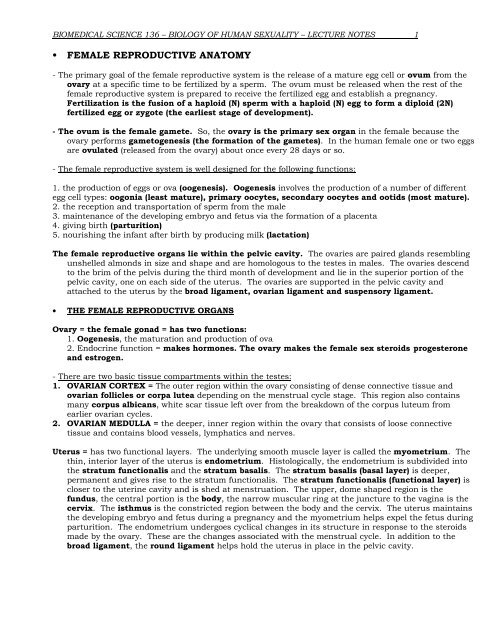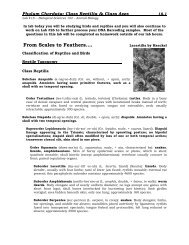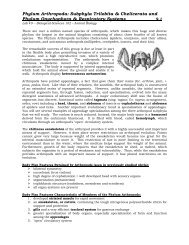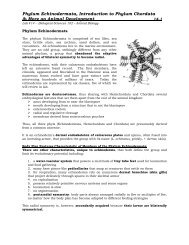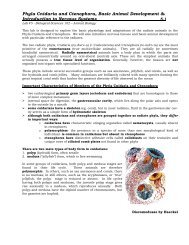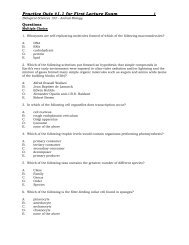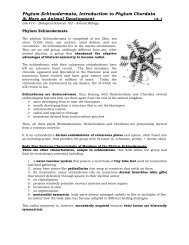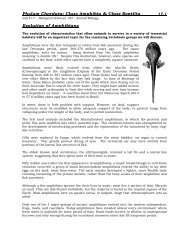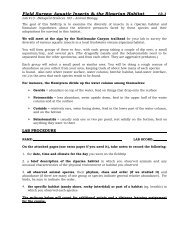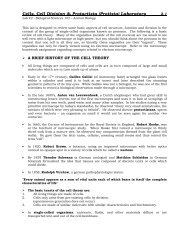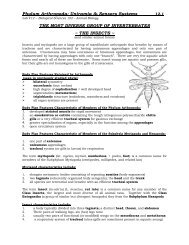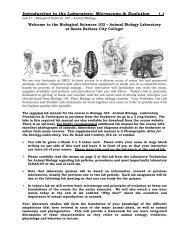Female Reproductive Anatomy - Biosciweb.net
Female Reproductive Anatomy - Biosciweb.net
Female Reproductive Anatomy - Biosciweb.net
Create successful ePaper yourself
Turn your PDF publications into a flip-book with our unique Google optimized e-Paper software.
BIOMEDICAL SCIENCE 136 – BIOLOGY OF HUMAN SEXUALITY – LECTURE NOTES 1• FEMALE REPRODUCTIVE ANATOMY- The primary goal of the female reproductive system is the release of a mature egg cell or ovum from theovary at a specific time to be fertilized by a sperm. The ovum must be released when the rest of thefemale reproductive system is prepared to receive the fertilized egg and establish a pregnancy.Fertilization is the fusion of a haploid (N) sperm with a haploid (N) egg to form a diploid (2N)fertilized egg or zygote (the earliest stage of development).- The ovum is the female gamete. So, the ovary is the primary sex organ in the female because theovary performs gametogenesis (the formation of the gametes). In the human female one or two eggsare ovulated (released from the ovary) about once every 28 days or so.- The female reproductive system is well designed for the following functions:1. the production of eggs or ova (oogenesis). Oogenesis involves the production of a number of differentegg cell types: oogonia (least mature), primary oocytes, secondary oocytes and ootids (most mature).2. the reception and transportation of sperm from the male3. maintenance of the developing embryo and fetus via the formation of a placenta4. giving birth (parturition)5. nourishing the infant after birth by producing milk (lactation)The female reproductive organs lie within the pelvic cavity. The ovaries are paired glands resemblingunshelled almonds in size and shape and are homologous to the testes in males. The ovaries descendto the brim of the pelvis during the third month of development and lie in the superior portion of thepelvic cavity, one on each side of the uterus. The ovaries are supported in the pelvic cavity andattached to the uterus by the broad ligament, ovarian ligament and suspensory ligament.• THE FEMALE REPRODUCTIVE ORGANSOvary = the female gonad = has two functions:1. Oogenesis, the maturation and production of ova2. Endocrine function = makes hormones. The ovary makes the female sex steroids progesteroneand estrogen.- There are two basic tissue compartments within the testes:1. OVARIAN CORTEX = The outer region within the ovary consisting of dense connective tissue andovarian follicles or corpa lutea depending on the menstrual cycle stage. This region also containsmany corpus albicans, white scar tissue left over from the breakdown of the corpus luteum fromearlier ovarian cycles.2. OVARIAN MEDULLA = the deeper, inner region within the ovary that consists of loose connectivetissue and contains blood vessels, lymphatics and nerves.Uterus = has two functional layers. The underlying smooth muscle layer is called the myometrium. Thethin, interior layer of the uterus is endometrium. Histologically, the endometrium is subdivided intothe stratum functionalis and the stratum basalis. The stratum basalis (basal layer) is deeper,permanent and gives rise to the stratum functionalis. The stratum functionalis (functional layer) iscloser to the uterine cavity and is shed at menstruation. The upper, dome shaped region is thefundus, the central portion is the body, the narrow muscular ring at the juncture to the vagina is thecervix. The isthmus is the constricted region between the body and the cervix. The uterus maintainsthe developing embryo and fetus during a pregnancy and the myometrium helps expel the fetus duringparturition. The endometrium undergoes cyclical changes in its structure in response to the steroidsmade by the ovary. These are the changes associated with the menstrual cycle. In addition to thebroad ligament, the round ligament helps hold the uterus in place in the pelvic cavity.
BIOMEDICAL SCIENCE 136 – BIOLOGY OF HUMAN SEXUALITY – LECTURE NOTES 2Fallopian tubes (or oviducts or uterine tubes) = transport ova (eggs) from the ovary to the uterus andsperm from the uterus toward the ovary. There is a fluid that flows through the oviducts and cilia inthe walls of the Fallopian tubes which beat to transport the ovulated egg toward the uterus. Theinfundibulum is the funnel shaped portion of the tube near the ovary, the ampulla is the widest,longest portion and the isthmus is the more medial, short, narrow, thick portion attached to theuterus. Fertilization usually occurs in the Fallopian tubes, typically in the ampulla regionnear to the ovary.Fimbriated funnel (or Fimbriae) = a funnel like structure with fingerlike projections that receives theovulated egg from the ovary and carries it to the Fallopian tubes.Cervix = a muscular structure that projects from the uterus into the vagina and guards the entrance tothe uterus. The cervical canal serves as both a pathway for sperm and as the passageway for deliveryat parturition. There is a mucus which is secreted from the cervix which changes in consistencyduring the menstrual cycle.Vagina = a fibromuscular expansive tube which connects the uterus to the external environment. Atejaculation, sperm are deposited into the vagina and must be transported through the cervix anduterus to the Fallopian tubes where fertilization usually occurs. The mucosa of the vagina iscontinuous with that of the uterus and is folded into rugae. At the inferior end of the vagina theremay be a thin fold of vascularized mucous membrane over the vaginal orifice called the hymen.Sometimes the hymen completely covers the orifice and may require surgery to open the orifice andpermit the discharge of menstrual flow.External female genitalia are collectively called the vulva. The vulva includes the mons, clitoris,vestibule, labia majora, labia minora and vaginal opening.• Specifics about the ClitorisThe clitoris lies at the junction of the upper of the two labia minora above the urethral opening.- The average length is about 2.5 cm (1 inch) with an average diameter of ½ inch. There is muchindividual variation with regard to size and shape.- The clitoral shaft (similar to the penile shaft) contains a pair of corpora cavernosa spongy tissuecylinders. There is no corpus spongiosum in the clitoris. This tissue is the labia minora in females(same embryological origin as the corpus spongiosum in the penis).The clitoral glans (head or tip) is covered by the clitoral prepuce (similar to the foreskin of the penis).The clitoris is rich in deep pressure and temperature receptors with only few touch receptors. Plays animportant role in sexual arousal. During the plateau phase the deep pressure receptors are importantfor detecting stimulation of the retracted clitoris through the clitoral hood and mons.Perineum = the diamond shaped area medial to the thighs and buttocks of both males and females thatcontains the external genitalia and the anus. It is bounded anteriorly by the pubic symphysis,laterally by the ischial tuberosities and posteriorly by the coccyx. A transverse line drawn between theischial tuberosities dividies the perineum into an anterior urogential triangle that contains theexternal genitalia and a posterior anal triangle that contains the anus.Important muscles of the pelvic floor in both males and females: bulbospongiosus,ischiocavernosus, levator ani (iliococcygeus & pubococcygeus), urogenital diaphragm
BIOMEDICAL SCIENCE 136 – BIOLOGY OF HUMAN SEXUALITY – LECTURE NOTES 3HOMOLOGOUS STRUCTURES OF MALE AND FEMALE REPRODUCTIVE SYSTEMSMALETESTESSPERMSCROTUMSPONGY (PENILE) URETHRA (PENOSCROTAL RAPHE)MEMBRANOUS URETHRACORPUS SPONGIOSUM AND BULB OF PENISGLANS PENIS (HEAD)PROSTATE GLANDBULBOURETHRAL(COWPER’S) GLANDSGUBERNACULUMFEMALEOVARIESOVUMLABIA MAJORALABIA MINORAVESTIBULEBULB OF VESTIBULECLITORISPARAURETHRAL GLANDSGREATER VESTIBULAR(BARTHOLIN’S) GLANDSROUND LIGAMENT• HORMONAL CONTROL OF THE FEMALE REPRODUCTIVE SYSTEM- The first day of the menstrual cycle is the first day of menstruation (the first day of blood loss from theuterus). The menses (menstruation) usually last 5 to 7 days. The average menstrual cycle lasts about28 days.Testosterone has the following effects in the female: (mostly from the adrenal cortex)1. responsible for sex drive (libido)2. maintains muscle massTHE FOLLICULAR PHASE OF THE MENSTRUAL CYCLE- During the follicular phase (the first 14 days of the menstrual cycle), the granulosa cells and thecainterna cells in the developing follicles in the ovary produce increasing amounts of estrogen, butvirtually no progesterone. The estrogen (mainly estradiol) which is released prepares the rest of thefemale reproductive tract for a pregnancy.Estrogen (estradiol) has the following effects in the female during the follicular phase:1. maintenance and development of the secondary (accessory) sexual organs (e.g. the vagina, uterus,Fallopian tubes, fimbriated funnel, the cervix)2. maintenance and development of the secondary sexual characteristics (e.g. softer skin, breastdevelopment and growth, higher voice, fat deposition around the hips)3. travels to the follicles to help stimulate oogenesis4. inhibits the release of FSH from the anterior pituitary (adenohypophysis)5. stimulates the proliferative phase of the endometrium in the uterus6. causes the cervical mucus to become copious, watery and hospitable to sperm. This cervical mucuswill dry in a characteristic "fern-leaf" pattern on a microscope slide.- As the follicle matures into a Graafian follicle (the most mature follicle type) estrogen levels increase untilan estrogen surge occurs about 48 hours before ovulation. The estrogen surge is a sudden, rapidincrease in estrogen secretion over a short period of time (less than 24 hours).- This estrogen surge from the Graafian follicle in the ovary stimulates ovulation by causing a surge in LHrelease from the anterior pituitary by positive feedback about 24 hours before ovulation. That is,the more estrogen that is released, then the more LH that is released. The LH released during the LHsurge travels to the ovary and stimulates ovulation (ovulation is the release of the oocyte from theovary and into the fimbriated funnel).- During most of the follicular phase, the increasing estrogen levels inhibit FSH release from theanterior pituitary by negative feedback. This is how the combination oral contraceptive (whichcontains both estrogen and progesterone) can prevent pregnancy. A woman who is taking thecombined oral contraceptive does not typically ovulate because her follicles do not develop (she has lowFSH secretion) and her ovaries do not release an estrogen surge (so she does not ovulate).


